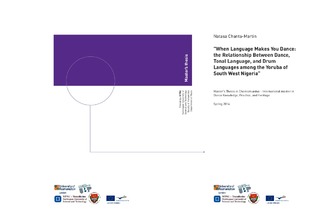When Language Makes You Dance: the Relationship between Dance, Tonal Language, and Drum Languages among the Yoruba of South West Nigeria
Master thesis
Permanent lenke
http://hdl.handle.net/11250/2504871Utgivelsesdato
2014Metadata
Vis full innførselSamlinger
- Institutt for musikk [501]
Sammendrag
Among the Yoruba people of southwest Nigeria, dancers have the ability to relate not only to music and rhythm, but also to the Yoruba tonal language. This is due to the fact that instruments being played during a dance event, once they are manipulated by the drummer, can follow the Yoruba language’s tonality. Therefore, the so-called talking drums are able to articulate proverbs, poems, stories. The dancers’ appropriations and interpretations of what the drums are saying create different artistic and cognitive layers during their dancing. Through Victor Turner’s observations on the ritual symbol, this dissertation analyses the polarisation of meaning identified in two different drum languages. The first one derives from the Yoruba spoken language and is used by the talking drummer to share knowledge on Yoruba culture with the dancers. The second drum language consists of onomatopoeic rhythms, which are used by individuals to verbally direct the dance in educational and performance situations. Both of the drum languages are actualised in the Yoruba context within multiple dancing layers. Although, Yoruba dance is seen a creative and innovative manifestation of the individual, the reoccurrence of proverbs and repetition of rhythms establishes a platform for intergenerational community-making. However, how does the younger generation contribute to this identity, since it is claimed that the Yoruba language is becoming endangered? Going beyond choreomusical relationships, this dissertation aims to introduce the phenomenon of layering in Yoruba dance, which derives from exploring the personal dance experiences of a community of practice in Yorubaland.
Utgiver
NTNUBeslektede innførsler
Viser innførsler beslektet ved tittel, forfatter og emneord.
-
Focus on language in CBI: How teacher trainees work with language objectives and language-focused activities in content-based lessons.
Krulatz, Anna (Chapter, 2021)This paper investigates to what extent teacher trainees who had received instruction in pedagogical linguistics incorporate language learning in content-based (CBI) lessons. Data were collected from Likert-scale self-reports ... -
Finding Layers in the Gaga Movement Language - A Study of Lived Experience of the Gaga Movement Language in the Dancing Community Gaga/people at the Suzanne Dellal Centre, Tel Aviv
Hogstad, Ine Terese (Master thesis, 2015)I denne oppgaven har jeg forsket på levd erfaring med bevegelsesspråket Gaga i dansesamfunnet Gaga/people ved Suzanne Dellal Centre i Tel Aviv. Bevegelsesspråket Gaga ble utviklet av Ohad Naharin på slutten av 1990-tallet. ... -
Children with language impairment in Tanzania - A qualitative study about how special education teachers experience working with children with language impairment in pre-schools
Mgaya, Emiliana P. (Master thesis, 2017)The main theme is children with language impairment in Tanzania. The specific theme is about how special education teachers experience working with children with language impairment in pre-schools. The goal of the study ...
